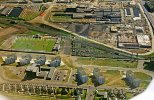From reading Tony Sayer's book, it would appear that - following the success of the trial re-engining of D6123 in 1963 - The BRB authorised the expenditure on a further 20 Paxman Ventura engines and it was decided to convert locos from the stored pool in order to maintain the maximum possible number of locos in traffic. Most of those chosen were stored due to fairly minor fire or collision damage and their conversion was deemed to be relatively cost-effective at the time. The 'blue star' class 21s (D6138-57) had been allocated to the Scottish Region from new, firstly at Kittybrewster depot in Aberdeen and then, after its closure at Ferryhill. They were considered to be better maintained - both internally and externally - than their Eastfield sisters and certainly suffered fewer fires and failures, so would probably have been at the end of the list for conversion. The final production series Paxman engine should have gone into D6109, which was already refurbished, repainted in 'Rail Blue' livery and given four character headcode panels at Inverurie works in late 1967; but it was found to have had earlier engine bed modifications which rendered it unsuitable to receive a Ventura. Therefore it was fitted with a refurbished NBL/MAN engine and returned to service for less than a year before withdrawal.....looking for all the world like a 29, but actually still a 21. Shortly afterwards, BR's National Traction Plan, which involved the elimination of all small, non-standard classes, was published and no more class 29 conversions were authorised.


